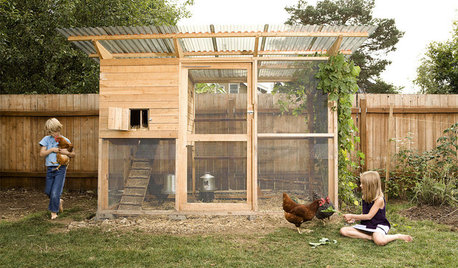Any tricks to finding cuccoons and whether worms are eating?
JamesMarconnet
12 years ago
Related Stories

GARDENING GUIDESHouzz TV: Make a Worm Bin for Rich Soil and Happy Plants
A worm-powered compost bin that can fit under a sink turns food scraps into a powerful amendment for your garden. Here’s how to make one
Full Story
BUDGET DECORATING9 Tricks to Boost Your Home’s Appeal for Less Than $400
Whether you’re redecorating or just doing a quick update, check out these ways to enhance your home on a budget
Full Story
DECORATING GUIDESHouzz Tour: Clever DIY Tricks Warm a Rustic Rental Cottage
An interior designer finds ways to beautify her family’s temporary home — and still keep the landlord happy
Full Story
DECORATING GUIDES9 Stylist Tricks for a Decorator Look
You don’t need to be rolling in cash to pull in compliments for polished, eye-pleasing rooms
Full Story
DECORATING GUIDESCompact Living: Tips and Tricks for Every Room
From big-picture insight to detailed room-by-room strategies, these guides will help you get the most out of a tricky area
Full Story
PRODUCT PICKSGuest Picks: 20 Finds to Cluck About
If you have or love chickens, you’ll flock to these coops, themed accessories, artwork and more
Full Story
KITCHEN DESIGNWhite Appliances Find the Limelight
White is becoming a clear star across a broad range of kitchen styles and with all manner of appliances
Full Story
FEEL-GOOD HOME21 Ways to Waste Less at Home
Whether it's herbs rotting in the fridge or clothes that never get worn, most of us waste too much. Here are ways to make a change
Full Story
LIFE3 Ways to Get Unstuck — About Organizing, Decorating, Whatever
Break out of the do-nothing rut to accomplish your goals, whether at home or in other parts of your life
Full Story
MOST POPULAR7 Ways to Design Your Kitchen to Help You Lose Weight
In his new book, Slim by Design, eating-behavior expert Brian Wansink shows us how to get our kitchens working better
Full StorySponsored
Custom Craftsmanship & Construction Solutions in Franklin County
More Discussions






equinoxequinox
Worms4Tracy
Related Professionals
Cary Landscape Architects & Landscape Designers · Deer Park Landscape Architects & Landscape Designers · Glendora Landscape Architects & Landscape Designers · Prairie Ridge Landscape Architects & Landscape Designers · Cary Landscape Contractors · Corona Landscape Contractors · El Reno Landscape Contractors · El Sobrante Landscape Contractors · Fort Wayne Landscape Contractors · North Richland Hills Landscape Contractors · Paramus Landscape Contractors · San Carlos Park Landscape Contractors · Maplewood Landscape Contractors · Mankato General Contractors · Perrysburg General ContractorsJamesMarconnetOriginal Author
JamesMarconnetOriginal Author
Worms4Tracy
PeterK2
JamesMarconnetOriginal Author
colin3
JamesMarconnetOriginal Author
equinoxequinox
rookie09